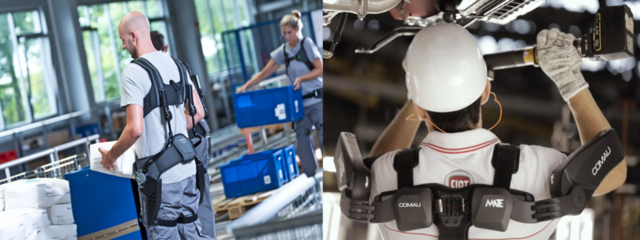
ExoFitStyria - Exoskeletons to prevent physical overload of workers in Styrian industry
Researchers at the Institute for Innovation and Industrial Management at Graz University of Technology are investigating, as part of the ExoFitStyria project, how employees in Styrian industry can be kept in employment longer and healthier through innovative technologies. In particular, the technology of exoskeletons could make a significant contribution here if employees are familiar with it and use it regularly and purposefully. The research project is funded by the Styrian Chamber of Labour.
The economic burden of musculoskeletal disorders
Musculoskeletal disorders (MSDs) cause more than one third of all work-related illness costs in Austria.
According to relevant studies, MSDs are associated with heavy physical work, repetitive movements or forced postures. These risk factors frequently occur in small and medium-sized enterprises (SMEs) in the production sector. In Styria, almost all workers in the production sector are employed in SMEs, which is why the prevention of MSDs in this sector is of particular importance.
Exoskeletons as individual assistance technology
Exoskeletons are wearable devices that augment, enable, assist or enhance motion, posture or physical activity. Originally developed for medical rehabilitation and military applications, exoskeletons are becoming increasingly important for industrial workplaces.
Especially when technical and organizational design measures have been exhausted, or other preventive measures are not feasible or effective, the targeted use of exoskeletons can serve as a preventive measure for musculoskeletal disorders and contribute to improving working conditions.
Need for field studies in real work environments
Although there are already several studies demonstrating the effects of exoskeletons in laboratory situations, there is still a lack of field studies in real work environments.
The lack of understanding of the biomechanical effects in exoskeleton-assisted work tasks and the lack of ergonomic assessment tools that specifically address the risk factors involved are barriers to the implementation of such systems in companies. In general, there is also still a lack of (1) evaluation in specific industries, especially SMEs, (2) knowledge of companies and employees about the effects and benefits of exoskeletons, (3) methodological knowledge for the implementation in existing processes, and (4) simple tools and procedures applicable to practitioners.
Project goals and approach
The three primary objectives of the ExoFitStyria project are (1) to determine the suitability as well as the relief effect of different exoskeletons for Styrian industry (with a focus on SMEs); (2) to set up a training infrastructure (ExoLab) and to develop a concept for measuring the relief effect of exoskeletons; and (3) to develop training concepts for ergonomic and age-appropriate work design and support by means of physical assistance systems and to pilot the implementation of the training concept with members of the Styrian Chamber of Labour.
For this purpose, in a first step, different assistive technologies are investigated in operational case studies with several companies regarding their practical suitability. An evaluation of the effects is planned by means of qualitative surveys and quantitative measurement methods.
Subsequently, the problems and requirements identified in the case studies will be transferred into exemplary use cases and implemented in the ExoLab as a training environment. The ExoLab as an isolated test environment for the achievable relief per use case shall show how the technologies can be used under ideal laboratory conditions and which benefits can be achieved in this idealized environment.
Finally, a modular training concept consisting of theoretical and practical parts will be created and adapted to the existing infrastructure.
